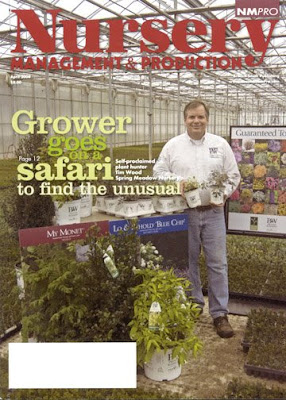
As I’ve said previously, one of the most satisfying aspects of hunting for and introducing new plants is getting affirmation that you’ve introduced a good plant. When growers and gardeners respond positively then I know my eye for a good plant is still working and on the right track. On that front, this last week has been a good one.
Just today I received a report from the Royal Horticulture Society at Wisley (England). They’ve been conducting an all European Buddleia trial that includes all cultivars available in the trade. That’s 107 different Buddleia cultivars in all, so the competition is very intense. In public voting this year, between July 31st to August 20th, , the top vote getters, by a decisive margin, were Buddleia x ‘Miss Ruby’ and Lo & Behold™ ‘Blue Chip’ respectively. The trial coordinator commented that the votes for Lo & Behold™ ‘Blue Chip’ would most likely have been even higher had the voting continued longer. That is because Lo & Behold™ ‘Blue Chip’ continued to flower well beyond all other cultivars. This is great news and is a good indication that each plant is in the running for the prestigious RHS award of Garden Merit. Dr. Denny Werner should be pleased that his plants took the top two spots. I expect that his breeding will garner ever more accolades in the future, as his Buddleia breeding is the best in the world.
Just today I received a report from the Royal Horticulture Society at Wisley (England). They’ve been conducting an all European Buddleia trial that includes all cultivars available in the trade. That’s 107 different Buddleia cultivars in all, so the competition is very intense. In public voting this year, between July 31st to August 20th, , the top vote getters, by a decisive margin, were Buddleia x ‘Miss Ruby’ and Lo & Behold™ ‘Blue Chip’ respectively. The trial coordinator commented that the votes for Lo & Behold™ ‘Blue Chip’ would most likely have been even higher had the voting continued longer. That is because Lo & Behold™ ‘Blue Chip’ continued to flower well beyond all other cultivars. This is great news and is a good indication that each plant is in the running for the prestigious RHS award of Garden Merit. Dr. Denny Werner should be pleased that his plants took the top two spots. I expect that his breeding will garner ever more accolades in the future, as his Buddleia breeding is the best in the world.

I also got word that one of our new Oso Easy™ Roses won an award. The Rose Hills International Rose Trial awarded a Gold Medal to Oso Easy™ ‘Paprika’ as the Best New Ground Cover rose for 2008. Congratulations to Chris Warner and his outstanding breeding of disease resistant roses. Awards are nothing new to Chris. He has won over 100 international awards including two President’s Trophies and three Gold Stars.





 Jasminum officinale 'Flona's Sunrise'
Jasminum officinale 'Flona's Sunrise'





































